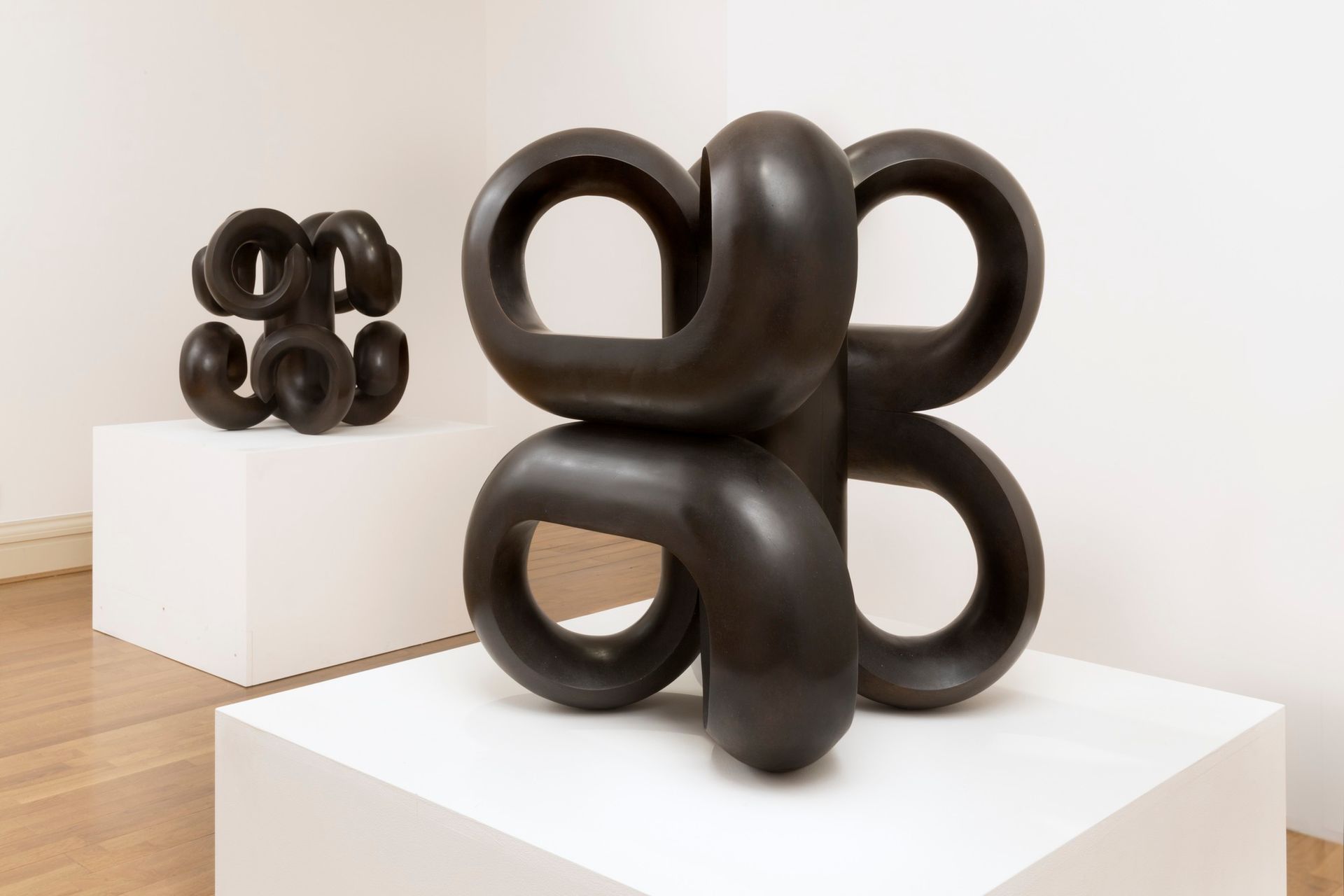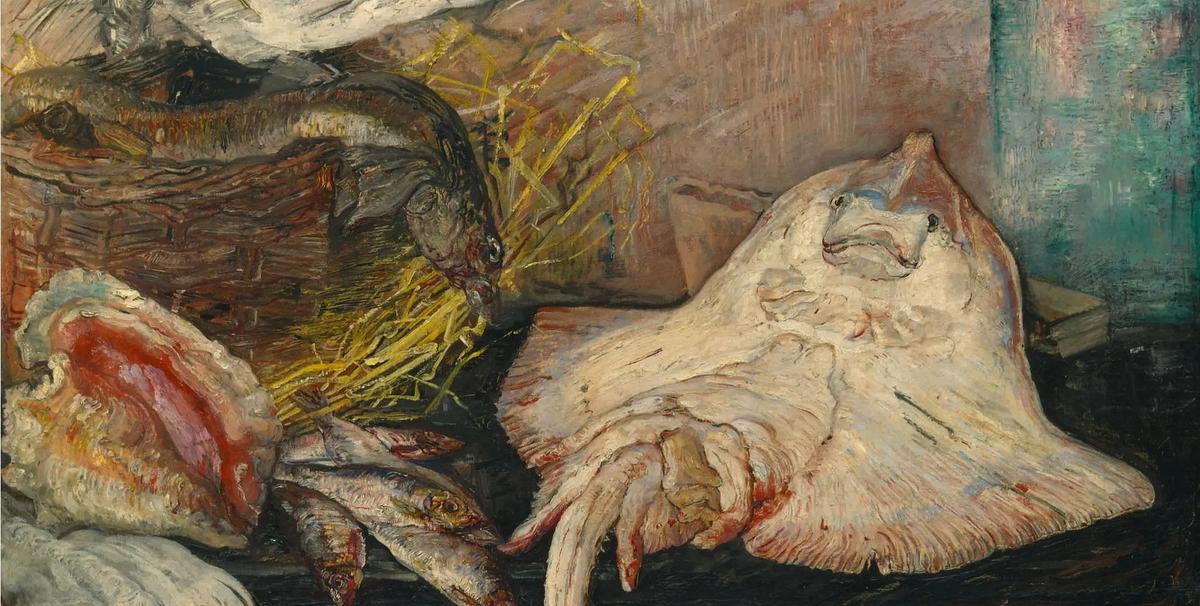Intrigue: James Ensor by Luc Tuymans, Royal Academy of Arts (until 29 January)
Luc Tuymans first encountered the great, grotesque James Ensor painting Intrigue, which gives this exhibition its title, when he was just a teenager and found it “a very fearful thing to look at”. By curating this most intriguing of shows, Tuymans—himself no slouch in the fear department—amply fulfills his aim to “reactivate” the odd, uncategorisable and also presciently-Expressionist work of his fellow Belgian. The ghoulish, garish masked throng of Intrigue is one among many works at the Royal Academy of Arts in which Ensor brilliantly combines the festive with the macabre. In both his paintings and prints, skeletons jostle in elaborate headgear, brandish umbrellas and broomsticks, huddle around stoves, and—in one of the show’s most memorable images—even engage in an oral tussle over a herring. It’s no coincidence that Ensor’s home town of Ostend is renowned for hosting Belgium’s largest annual carnival.
To underline this folkloric connection Tuymans also introduces real carnival masks and an exuberantly feathered headdress, along with his own spectral painting of the Gilles de Binche carnival character, topped off with the same elaborate headgear. The only other Tuymans work included is a previously unseen etching he made in direct response to Ensor when an 18-year-old art student. But the rich range of work spanning Ensor’s career beyond his glory years of the 1880s and 1890s, and up to his death in 1949, reveals that the artist’s danse macabre extended further and deeper than rattling bones and grand fiestas. Ensor’s inventive, satirical and at times scatological eye also conjures up swirling crowds of farting, fighting Ostenders who strike, feast, cavort on the beach and almost subsume the figure of Christ as he enters the Belgian city on a donkey. In other works, angels fight devils, bad doctors disembowel their victims and chefs serve up the heads of critics on plates.
But whatever Ensor is painting, the atmosphere crackles with a very contemporary ambiguity where there is a tenderness in his caricature, a nihilism in his energy and where no easy interpretation is offered. Nowhere is this more the case than in the obscenely fleshy form of a giant ray, which, in a huge and deeply disconcerting painting, shakes up all traditions of Flemish still life as it lies splayed alongside the positively pornographic gaping form of a seashell.

Paul de Monchaux: Ten Columns, Megan Piper (until 20 January)
Ten Columns is small yet utterly satisfying show consisting of two recent bronze sculptures and a line of eight small carved limewood works from one of our most thoughtful and quietly significant sculptors. Paul de Monchaux has devoted some six decades to a rigorous but never austere investigation into the nuanced and complex ways in which invented forms can be made to generate an emotional response, and here we see the outcome.
The shapes of his sculpture are crisp, lucid and non-representational. Yet at the same time they are absolutely steeped in the human body, in the same way that all great architecture, whether ancient or modern, always has human physicality and experience at its core. This deep understanding of the structures and parameters of human space is why his larger public sculpture is so successful. His steel memorial to the Second World War slave workers of the Jersey tunnels; his granite memorial to Wilfred Owen in the grounds of Shrewsbury Abbey; or the horribly neglected but still glorious stone benches outside Euston train station, are just a few of his public works.
The longer you look at these sculptures the more subtle, complex and rewarding they become, whether the voluptuous but also tautly contained curves of his two Volute bronzes (2013 and 2016) or the subtle curves, angles and straight lines of his carved wooden Eight Studies for Male & Female Columns (2016). For at the same time as their forms appear resolved almost to the point of inevitability, both physically and conceptually these most human and humane works also remain open to myriad points of view.

Huma Bhabha, Stephen Friedman Gallery (until 28 January)
Huma Bhabha is known for conjuring bizarre and unsettling beings out of the most banal everyday materials and here her new sculptures most emphatically take no prisoners. These sacred monsters also span a formidable range of cultures and civilisations. A colossal craggy head of paint-blackened cork, topped off with shredded shards of rubber seems part Cycladic and part cyborg, while a pair of giant totem-like matriarch figures are fashioned from more cork and spray-painted Styrofoam packaging. The sole occupant of the main gallery space is a prone personage that seems to be part sacrificial victim and part demonic deity, with its torn T-shirt and huge curling antelope horns framing a disconcertingly genital void where a face should be.
This omnivorous eclecticism is also very much in evidence in the new large scale photographic works. These take as their starting point photographs taken by Bhabha in Berlin and Karachi of scrubby building sites, ditches and pools of water that are then blown up to more than two metres in height before being vigorously painted, drawn and collaged-on, to the extent that the original image can be almost obliterated. What results is a suggestive series of faces and figures that appear both to be embedded in, and emerging out of, the landscape. More rich texture and multiple readings are given by the addition of newspaper and magazine clippings—with a particular penchant for clusters of sappy cannabis buds snipped from that classic stoner bible, High Times. As Bhabha says, “I’m always looking for different materials to add to the language.”

Anselm Kiefer: Walhalla, White Cube Bermondsey (until 12 February)
Feeling a bit wobbly about the impending events of 2017? Fear that we are spiraling into imminent global catastrophe? Then there’s no better show to visit than this awe-inspiring gloom-fest of thunderingly epic proportions. For when it comes to apocalyptic visions, without doubt Anselm Kiefer’s the Daddy.
Both literally and figuratively, Walhalla is a weighty show that amply lives up to its expansive Wagnerian title and in which no production expense has been spared. Of course there’s lashings of Kifer’s trademark lead, the only material he considers to be “heavy enough to carry the weight of human history”. There are lead-encased door frames (which anxious attendants warn you not to touch); the initial dimly-lit metallic chamber is lead-lined and filled with a double procession of grim hospital beds draped with dusty crumpled lead blankets; and lead fills another library room groaning with ceiling-high shelves of toppling lead books and chunks of redundant machinery.
Both Kiefer’s sculpture and his gigantic new paintings comfortably fill White Cube’s hanger-like spaces and could also stand in as props and scenery for a full-on, high end production of Götterdämmerung. But amidst the drama of Kiefer’s paintings—which use an even more extensive range of media than usual to depict their images of toppling stacked towers set amidst extensive desolate landscapes—there’s a also a JMW Turner-like delicacy in their misty atmospheric effects and flashes of vivid ultramarine blue cutting through the smog. For even this most ominous, operatic vision allows a glimmer of hope to appear on the horizon.



